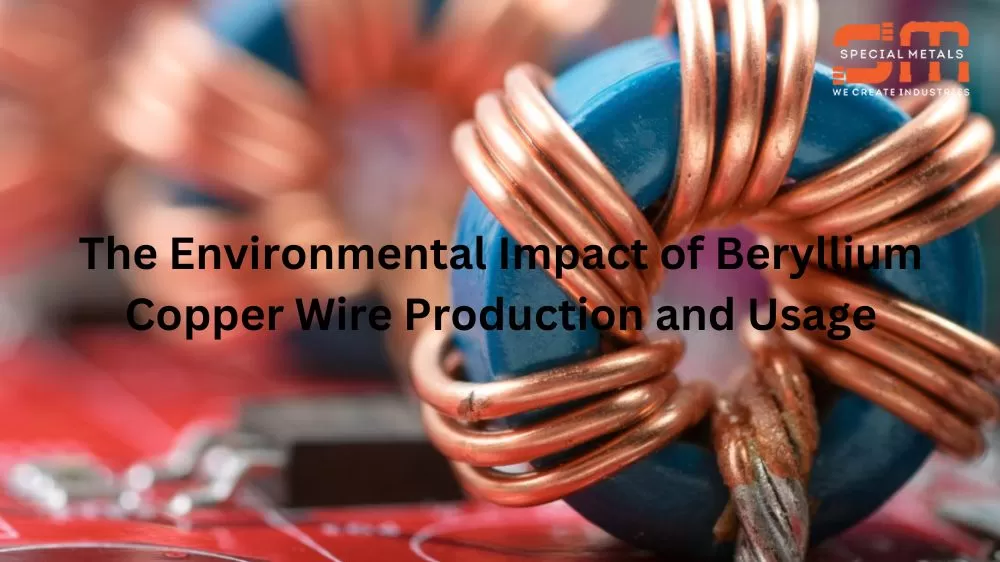Beryllium copper is a material frequently used in various industries, especially for producing wire. Beryllium copper wires are known for their high strength, conductivity, and corrosion resistance, making them ideal for applications such as electrical and electronic connectors, springs, and even aerospace components. However, the production and usage of beryllium copper wire also have significant environmental impacts that should not be ignored. In this blog post, we will discuss the environmental impact of beryllium copper wire production and usage and how we can minimize its impact on our planet.
What is Beryllium Copper Wire?
Beryllium copper wire is a type of conductive, corrosion-resistant alloy composed primarily of copper and beryllium. It has a high electrical and thermal conductivity yet still retains good strength at elevated temperatures. The alloy also has excellent wear characteristics, making it well-suited for applications such as switchgear terminals, electromagnetic windings for motors and generators, connectors, contact studs in electric arcs, springs and other components that need to resist arcing or welding. Its unique combination of properties makes the application possibilities nearly endless – from electrical connectors in automotive engines to spark plug wires for aircraft. Regarding 21st-century metalworking equivalents – Beryllium Copper Wire is highly regarded as an extraordinary player on the field!
Environmental Impact of Beryllium Copper Wire Production and Usage
Beryllium Mining and Processing
The direct environmental impact of beryllium copper wire production is related to the mining and processing of beryllium itself. Beryllium is a rare element that is usually found in the form of beryl or bertrandite in the Earth’s crust. Mining and processing of beryllium ore can release toxic waste materials, including heavy metals and radioactive materials, into the environment. These wastes can pollute soil, water, and air, leading to serious health problems for humans, animals, and plants. Additionally, the transportation of beryllium ore from the mining site to the processing plant can also contribute to carbon emissions, which can further harm the environment.
Energy Consumption and Carbon Emissions
The production of beryllium copper wire also requires a significant amount of energy, mainly from fossil fuels. Fossil fuels are associated with carbon emissions, which contribute to climate change and other environmental problems. In addition to the energy consumption and carbon emissions during production, using beryllium copper wire in various applications also requires energy, contributing to the material’s overall environmental impact.
Disposal and Recycling
The disposal of beryllium copper wire can also have negative environmental impacts. If not properly disposed of, wires can end up in landfills, which can take years to degrade and release toxic materials into the soil and water. Recycling of beryllium copper wire can reduce the negative environmental impact of the material. Recycling not only reduces waste but also saves energy and reduces carbon emissions associated with the production of new wire. In addition, it also reduces the need to mine and process new beryllium ore.
Health Impacts
Beryllium oxide can also be formed in the environment from copper-beryllium alloys that are discarded and that corrode. Inhalation of beryllium dust or fumes can cause lung cancer or chronic beryllium disease (CBD), an irreversible respiratory disease. These health risks are not only confined to workers in the industry but also to people in the surrounding communities where beryllium copper wire is produced and used.
Minimizing the Impact
The production and use of beryllium copper wire do have negative environmental impacts, but there are ways to minimize these impacts. Implementing better extraction, refining, and waste management techniques can prevent the release of toxic materials into the environment. Renewable energy sources, such as solar or wind power, can reduce carbon emissions during production. Proper disposal of beryllium copper wire is also essential to prevent its release into the environment. Lastly, using alternative materials, whenever possible, will reduce the overall environmental impact of beryllium copper wire.
Conclusion:
In conclusion, while beryllium copper wire is useful in various industries, its production and use have significant environmental impacts. The mining and processing of beryllium ore can release toxic waste materials, while the production and use of beryllium copper wire consume a significant amount of energy and contribute to carbon emissions. The disposal of beryllium copper wire can also have negative environmental consequences. Therefore, minimizing the environmental impact of beryllium copper wire is important by implementing better production methods, using renewable energy, proper disposal, and exploring alternative materials. As consumers, we also play a vital role in reducing the demand for such materials by recycling and promoting the idea of sustainable manufacturing practices.






